RICHARD’S “CANADA AM” REVIEWS FOR MAY 15 WITH BEVERLY THOMSON.
 Richard’s “Canada AM” reviews for “Mad Max: Fury Road,” “Pitch Perfect 2” and “Good Kill.”
Richard’s “Canada AM” reviews for “Mad Max: Fury Road,” “Pitch Perfect 2” and “Good Kill.”
Watch the whole thing HERE!
 Richard’s “Canada AM” reviews for “Mad Max: Fury Road,” “Pitch Perfect 2” and “Good Kill.”
Richard’s “Canada AM” reviews for “Mad Max: Fury Road,” “Pitch Perfect 2” and “Good Kill.”
Watch the whole thing HERE!
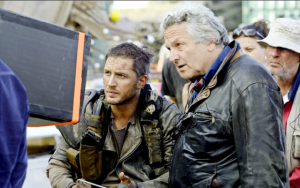 By Richard Crouse – Metro In Focus
By Richard Crouse – Metro In Focus
George Miller has made pigs talk and penguins tap dance. He’s been a doctor and a film director. Among the bold faced names on his resume are the titles Babe: A Pig in the City, The Witches of Eastwood, Happy Feet 1 and 2 and Lorenzo’s Oil. One name, however, looms larger than the rest.
Mad Max. Over the course of three films—Mad Max, Mad Max 2: The Road Warrior and Beyond Thunderdome—he introduced the world to post apocalyptic warrior Max Rockatansky, made Mel Gibson a superstar, defined dystopian cinema for a generation or two and created the phrase, “Two men enter, one man leaves.”
This weekend, thirty years after the release of the last Mad Max movie, Miller revisits the character in Mad Max: Fury Road, a reboot starring Tom Hardy and Charlize Theron.
The seventy-year-old director, who raised money to make the first film by working as an Emergency Room Doctor, says the goal of the new movie was to make it “uniquely familiar.”
After years of “following the CG evolution,” using computer generated images to create beautiful animated films, he was keen to go back to “old school” filmmaking “with real cars and real people and real desert.” That means, unlike the Avengers and their ilk, respecting the laws of physics by using practical effects and keeping the action earthbound. In other words, in a call back to the original films, when a car blows up it doesn’t rocket into space. Instead it explodes spectacularly but organically. The wild action you see in Fury Road are actual stunts performed by stunt men and women and not generated by a clever computer operator in a studio.
“It was like going back to your old home town and looking at it anew,” he says.
Miller reveals he originally created Max’s wasteland world while practising medicine.
“I worked for two and half years in a big city hospital. I stayed registered right up past Mad Max 2: Road Warrior. I never even thought there’d be a career. I stayed as a doctor on the first Mad Max because we kept running out of money in postproduction. Then I stayed through to the second Mad Max because if you are doing stunts you are obliged to have a doctor on set. There weren’t big budgets so I ended up running a clinic during lunch time tending to cuts, sunburns, scrapes and all that.”
His two careers have much in common, he says, adding he was “was privileged with a unique point of view as a doctor.”
“I don’t think I’d be the filmmaker I am unless I had that medical education, in two very direct ways. Both of them have a lot of problem solving in there. But the most important way is that as a doctor you are looking at people in extremis from many points of view. You look inside of people. You see people during birth and death and so on. Through microscopes; a lens. So you’re looking from many, many points of view. That’s exactly what you do in cinema. Huge wide shots with massive crowds or you’re looking right down inside someone’s brain, someone’s head.”
As for plans to make another Mad Max right away, he says, “That’s a bit like asking a woman who’s just given birth if she’s going to have another baby.”
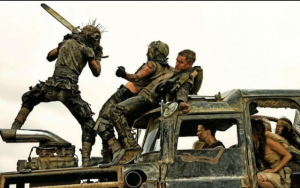 The ghostly War Boys of “Mad Max: Fury Road” have a catchy mantra they recite as they go into battle. “I live. I die. I live again!” In some ways it could be the refrain for the series. Begun as a down-and-dirty punk rock vision of a post-apocalyptic Australia, the 1979 no-budget movie made a star out of Mel Gibson and spawned a mini-franchise of two more films, “The Road Warrior” and “Beyond Thunderdome.”
The ghostly War Boys of “Mad Max: Fury Road” have a catchy mantra they recite as they go into battle. “I live. I die. I live again!” In some ways it could be the refrain for the series. Begun as a down-and-dirty punk rock vision of a post-apocalyptic Australia, the 1979 no-budget movie made a star out of Mel Gibson and spawned a mini-franchise of two more films, “The Road Warrior” and “Beyond Thunderdome.”
The George Miller films lived, died and now live again courtesy of “Mad Max: Fury Road,” an out-of-control reboot that recreates Max Rockatansky’s dystopian world and then races like hell through it, laying rubber all the way.
Set in an arid, inhospitable world where a snack of raw lizard constitutes a meal, Max (Tom Hardy) is a man who has lost everything, Haunted by “those he could not protect” he is now “a man reduced to a single instinct—survival.” Captured by henchmen of Immortan Joe (Hugh Keays-Byrne, who played Toecutter in the original “Mad Max”), a despot who hoards precious natural resources and only sparingly shares water with his subjects—Don’t take too much water, he says, you will only come to resent it when it isn’t there.—Max is turned into a blood bank for an ailing war boy named Nux (Nicholas Hoult). Subjected to a life of confinement and drained of his own natural resources, Max sees a chance for freedom when Nux and others do battle against Imperator Furiosa (Charlize Theron), a former warrior turned rogue. She’s driving the imposing War Rig—imagine a Monster Truck with an attitude—across the wasteland. With her are Immortan Joe’s five wives—Splendid (Rosie Huntington-Whiteley), Capable (Riley Keough), Toast (Zoë Kravitz), The Dag (Abbey Lee Kershaw) and Fragile (Courtney Eaton)—a natural resource he desperately wants back. Max and Furiosa form an uncomfortable alliance to battle the forces of evil and make it across the desert to Furiosa’s childhood home, a green oasis.
It’s been thirty years since there was a new “Mad Max” movie but “Fury Road” was worth the wait. The years have not stilled Miller’s restless camera or his outrageous way with steampunk influenced design or character names. If Imperator Furiosa isn’t the best character name of the year, I don’t know what is. Her title, however, might as well have been Mad Maxine as she is more the focus of the story than the titular character.
It is a chase movie where characters chase immortality, a new life in a better place, love and one another across a vivid landscape. Gone are the grey tones of dystopian movies like “The Road.” In its place is a dusty but vibrant backdrop that frames the non-stop action. Miller keeps the pedal to the metal but unlike the recent “Avengers: Age of Ultron,” which had a similar angle of attack, he keeps the action earthbound. The laws of physics are respected—when a car blows up it doesn’t rocket into space for instance—by the director’s use of practical effects. Most everything you see on screen are actual stunts performed by real people and not generated by a clever computer operator in a studio later on. The organic nature of most of (but not quite all) the visuals gives the movie extra torque, adding a sense of danger and realism (no matter how unreal the situation) to the large set pieces that make up the bulk of the film.
Hardy pulls his weight as Max. His powerful physicality mixed with a haunted look—maybe we should call him Passive Aggressive Max—and gearbox permanently shifted to survival makes him an imposing center of the film, but it is Theron who dominates.
As Furiosa she lives up to her name as a force to be reckoned with. She’s a one-armed bandit (literally) who not only provides much of the action in the film, but its heart as well.
The real star, however, is Miller. Thirty years after he last played in Mad Max’s world he revisits it with a film that doesn’t feel like a sequel or a reboot, but a fresh look at an familiar character. His off-the-wall sensibility and demented Hot Wheels style designs give the movie a look and feel that no other director could replicate.
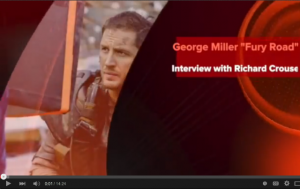 Richard talks with George Miller regarding his film “Mad Max: Fury Road”
Richard talks with George Miller regarding his film “Mad Max: Fury Road”
George Miller on his life as a doctor before taking up film making full time: “I worked for two and half years in a big city hospital. I stayed registered right up past Mad Max 2: Road Warrior. I never even thought there’d be a career. I was still interested in medicine. I went through medical school with my twin brother. I stayed as a doctor on the first Mad Max because we kept running out of money in post production. I was working and it took over a year to cut that film. Then I stayed through to the second Mad Max because if you are doing stunts you are obliged to have a doctor on set. There weren’t big budgets son I ended up running a clinic during lunch time tending to cuts, sunburns, scrapes and all that. The, as time went on, I realized from my twin brother that… I kept losing the knowledge and not keeping up with it. You can’t do both.”
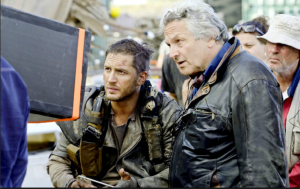 Richard will host a screening of the highly anticipated “Mad Max: Fury Road” on May 4 and do a Q&A with director George Miller.
Richard will host a screening of the highly anticipated “Mad Max: Fury Road” on May 4 and do a Q&A with director George Miller.
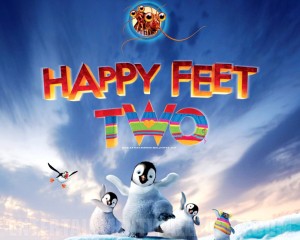 Five years ago I wrote, “Penguins are the new dogs. Not since the heyday of dog movies like Benji and Lassie has one species won over the hearts of so many. “ Penguins were all the rage, appearing in movies as diverse as “March of the Penguins,” the R-rated parody of that movie, “Farce of the Penguins,” family flicks like “Madagascar,” even something called “Penguins Behind Bars” and, of course the Oscar winning dancing penguin movie “Happy Feet.” You couldn’t swing a haddock without hitting a flock of movie penguins, but that was in 2006. The question today is, will people still want to watch waist-coaters do the soft shoe?
Five years ago I wrote, “Penguins are the new dogs. Not since the heyday of dog movies like Benji and Lassie has one species won over the hearts of so many. “ Penguins were all the rage, appearing in movies as diverse as “March of the Penguins,” the R-rated parody of that movie, “Farce of the Penguins,” family flicks like “Madagascar,” even something called “Penguins Behind Bars” and, of course the Oscar winning dancing penguin movie “Happy Feet.” You couldn’t swing a haddock without hitting a flock of movie penguins, but that was in 2006. The question today is, will people still want to watch waist-coaters do the soft shoe?
“Happy Feet Two” is a series of stories set against a similar theme. Eric (Elizabeth Daily), the son of Mumble (Elijah Wood) and Gloria (Pink) doesn’t have the natural grace of his dad, and like all kids is slightly embarrassed of his old man. Meanwhile Bill and Will (Matt Damon and Brad Pitt), leave the krill swarm, they have grown up in to make a life for themselves in the outside world and the Mighty Swen (Hank Azaria), an odd looking penguin, impresses Eric with his ability to fly. When a catastrophic natural disaster threatens the very existence of the penguin population, however, Eric, the krill and Swen learn what it really means to be a part of something large than yourself.
The original “Happy Feet” and its sequel don’t look or feel like other movies for kids. Director George “Mad Max” Miller is a maximalist director who opens up the usual kid flick palette with swooping cameras, wide-open vistas and beautifully effective 3D. Featuring a cast of thousands—animated penguins as far as the eye can see and “krillions” of krill—the movie is made on a scale that would make Cecil B. DeMille proud.
Story wise the movie also takes a different approach. It’s a blend of musical theatre—many of the story points are introduced or at last supported by epic tunes—inspired by the Emperor penguins who use heart songs to attract mates—and some traditional family themes—father and son conflict, the importance of family—but Miller also digs a little deeper and really examines why people form families.
Mix in a “free to be me and you” subplot about the consequences of conformity and a subtle environmental message and you have a movie that dispenses with the easy morality of most animated films. Who else but Miller would create Bill and Will, two new bug-eyed characters who can only be described as existential shrimps? Actually they are krill, a tiny marine crustacean, but just because they are small doesn’t mean they don’t have aspirations. And most of the movie’s best lines. They banter back and forth like Ionesco and Beckett discussing the vagaries of their limited lives. “I fear the worst,” says Will, “because fearing the best is a waste of time!” Small but mighty they are a highlight of the film.
“Happy Feet Two” is a step above most kid’s movies. It is joyful, beautiful to look at, and has more to say about life, love and the pursuit of happiness than most movies aimed at adults.
Go for the penguins, stay for the krill!
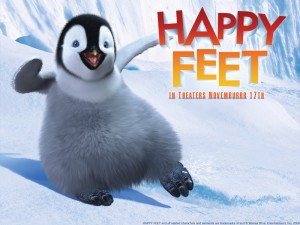 Penguins are the new dogs. Not since the heyday of dog movies like Benji and Lassie has one species won over the hearts of so many. March of the Penguins was a left field hit last year and an R-rated parody of that movie, Farce of the Penguins, is set to be released soon. The little furry birds have recently appeared in Madagascar, the 3-2-1 Penguins series and even something called Penguins Behind Bars. Everybody loves penguins, but will they love penguins who sing and dance? Mad Max director George Miller is counting on it.
Penguins are the new dogs. Not since the heyday of dog movies like Benji and Lassie has one species won over the hearts of so many. March of the Penguins was a left field hit last year and an R-rated parody of that movie, Farce of the Penguins, is set to be released soon. The little furry birds have recently appeared in Madagascar, the 3-2-1 Penguins series and even something called Penguins Behind Bars. Everybody loves penguins, but will they love penguins who sing and dance? Mad Max director George Miller is counting on it.
Miller’s latest film is Happy Feet, an animated film about a community of Emperor Penguins and one tap dancing misfit baby penguin who doesn’t quite fit in with the pack. With voice talent from an all-star cast (headlined by Nicole Kidman, Hugh Jackman, Elijah Wood and Robin Williams) the movie dispenses with the easy morality of most animated films digging a little deeper to explore the consequences of conformity and discuss important environmental concerns.
That may sound dull, but the movie is anything but. Miller’s stylish movie is jam-packed with music—Emperor penguins use heart songs to attract mates—and some first rate tap dancing that would make Sammy Davis Jr. proud. Younger kids may find one or two of the set pieces a little too intense. A chase scene with Mumbles the baby penguin on the run from a toothy seal lion is scary, but no more extreme than many of the real-life nature scenes in March of the Penguins.
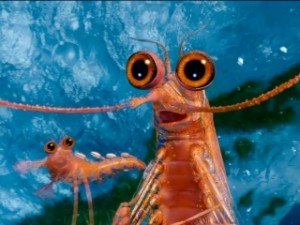 “One thing I am drawn to unconsciously is the hero myth,” says director George Miller.
“One thing I am drawn to unconsciously is the hero myth,” says director George Miller.
Looking over his resumé it’s easy to see what he means. His creations, like Mad Max, who ruled a dystopian Australian landscape from the driver’s seat of a Ford Falcon XB Coupe and Babe, the king of the barnyard, are agents of change in their own worlds.
In his new film, Happy Feet Two, the follow up to the Oscar winning dancing penguin musical of 2006, you’ll have to look closely to see his heroes, because they are the smallest creatures in the movie.
They are Bill and Will (Matt Damon and Brad Pitt), two bug-eyed characters who can only be described as existential shrimps. Actually, they’re krill – a minute marine crustacean.
“Happy Feet Two is not a saga,” he says. “It’s not the hero myth, except from the point of Will the Krill. From his point of view the world is epic because they are so tiny. He goes off on a classic hero myth, going out, looking into the unknown, confronting great dangers and bringing a boon back to his world.
“Because the film takes place in a truncated time period it was important to make it epic from some point of view. From the krill’s point of view it’s a very big world — universe — out there. We saw them like space explorers wanting to go out beyond their world.”
The krill may leave their flock — the “krillions” of krill they live with — to go on a journey, but Miller says the point of the story has more to do with family than heroes.
“They begin by being torn apart in some way,” he says, “and it is only in the coming together that they are able to solve the problem.”
For Miller, Happy Feet Two was a bit of a family affair, but not intentionally. He says he turned to his daughter to write the lyrics of the show-stopping tune Eric’s Opera because he was desperate.
“We had three very well-known writers who have written musicals in Australia to try and write some lyrics and it just wasn’t working,” he says. “It was over elaborate so I called her and said, ‘Can we just sit down together and work through it.’ In two hours she had it, but it was more out of desperation than wanting specifically to work with my daughter.”